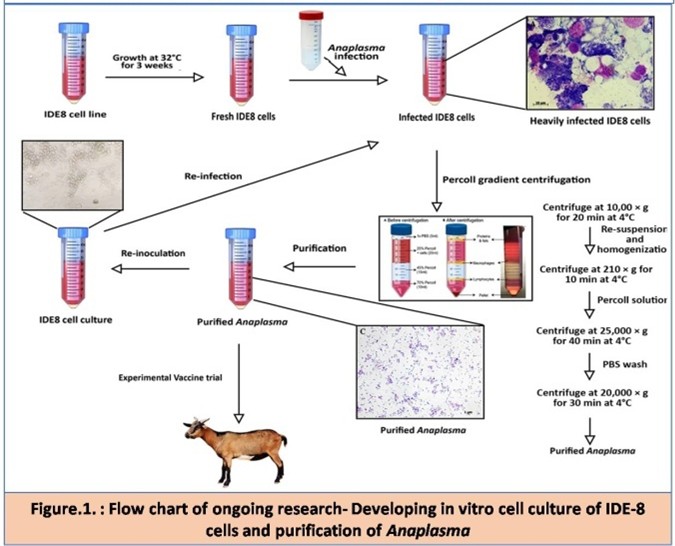Isolation, molecular characterization and vaccine development against bovine Anaplasma in Bangladesh

Professor Dr. AMAM Zonaed Siddiki
Principal Investigator
Chattogram Veterinary and Animal Sciences University
Anaplasmosis is one of the most common endemic rickettsial diseases in tropical and sub-tropical countries including Bangladesh. Farm level economic losses are directly related to morbidity, mortality, production losses together with the cost of veterinary diagnosis, treatment, and tick control. An alternative to the traditional vector control is developing immunity through use of locally circulating parasite species. During this project tenure, we aim to collect circulating field isolates/ strains/species of Anaplasma from selected endemic areas and successfully achieved their molecular characterization. We are now developing in vitro culture methods using IDE-8 cell lines derived from Ixodes scapularis tick species from our collaborators in University of Liverpool, UK and University of Malaya, Malaysia. We aim to grow sufficient amount of Anaplasma organisms to be used as novel vaccine candidates. During the last one year, we have collected more than 400 blood samples from five study areas. Alongside we collected tick vectors and identified them through morpho-taxonomy. With the blood samples we have identified the positive samples using conventional Giemsa stain and microscopy. In addition, PCR assay were performed to confirm the diagnosis of positive cases for future cell culture propagation. The infective Anaplasma is now under careful purification steps which will ensure pure culture of Anaplasma in IDE-8 cells which will be used as a vaccine material.
Tick gut epithelial cell (IDE-8 cell) will be used for propagation of Anaplasma in vitro. Later these will be heat inactivated to be used as vaccine materials in experimental goats. ELISA kits will be used to assess vaccine efficiency through assessing antibody levels before and after inoculation of cell culture stabilates from cell culture
Molecular characterization of circulating 6 strains of Anaplasma as revealed through PCR assay and sequencing followed by Phylogenetic analyses. (ii) Successful completion of development of Anaplasma in vivo growth in mouce model. (iii) PCR assay for detection of Anaplasma sp. from tick vectors collected from same cattle from which positive blood samples were confirmed earlier. (iv) Submission of 6 sequences of 16s rRNA gene fragments of Anaplasma sp. in global NCBI database. (v) One Research article (published) based on in silico data analyses in PLoS One Journal. [Citation: Siddiki AZ, Alam S, Fuad Bin Hossen F, Alim M.A (2025) Development of a multi-epitope chimeric vaccine in silico against Babesia bovis, Theileria annulata, and Anaplasma marginale using computational biology tools and reverse vaccinology approach. PLoS ONE 20(1): e0312262. https://doi.org/10.1371/journal. pone.0312262 ] (vi) Signing MOU with University of Liverpool, UK for further collaboration on Anaplasma research.
With successful propagation of cell culture derived Anaplasma sp., an experimental autogenous/ attenuated/ peptide vaccine will be made possible for further field trial. Standard methods of isolation, identification and molecular detection of rickettsia (Anaplasma) will be established and will be used in further relevant research in future. The standard operating procedures (SOP) and the autogenous vaccine (killed) developed can be patented and used for commercial level vaccine production once the field trial is satisfactory and all necessary legal permission from respective body is ensured.
• Anaplasmosis is an important deadly parasitic disease and farmers suffer from morbidity and mortality from this hemoprotozoa. There is no data on economic loss due to anaplasmosis in Bangladesh. However farmers are having serious problems with anaplasmosis as no vaccine is available in the market for this protozoan disease. • Present research is attempted to develop an autogenous experimental vaccine using cell culture derived parasite materials. This will be invaluable for dairy and crossbred cattle farms and increase productivity in the long run with fewer disease incidence. This will increase productivity of milk and meat and will ensure economically viable livestock farming around the country.
• CVASU Research and extension office has sufficient funding to support the sustainable production of the Anaplasma vaccine once seed materials will be available. • We have collaborated with local dairy farmers association to commercially supply hundreds of vaccines once we are successful. • The CVASU Animal hospital will be used for supply of vaccine to interested farmers and DLS/BLRI will be involved for sustainable production and extension of Anaplasma vaccine throughout the country. • University of Malaya TIDREC Center had signed collaboration agreement for commercial production of this vaccine and patenting for future industrial use. • University of Liverpool, UK –Tick cell biobank has promised for continued support for vaccine development effort and has signed bilateral agreement with CVASU research team.
